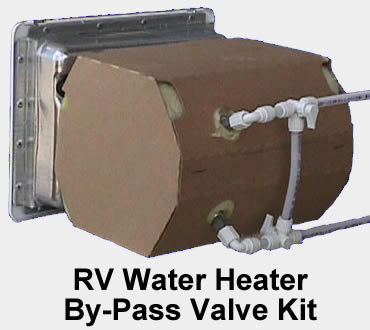RV Water Heater Basics
The Water Heater installed in your RV is primarily a propane gas appliance. The water heater installed in most RVs typically has a 6-gallon tank but larger RVs may have 10-gallon units.
Dependent upon the model installed, your RV water heater may operate only on gas or on gas and/or 120 Volt AC.
Your RV water heater may have a gas pilot light which will have to be lit each time you set up camp. Or it may have an automatic, direct spark ignition (DSI) system which allows the water heater to be operated by an electric switch inside the RV.

Your RV water may have a by-pass valve kit installed. The by-pass kit is a popular option that allows for easier drainage of the hot water heater tank and winterization of the unit saving time and reducing the amount of anti-freeze needed. The by-pass kit is installed near the cold water inlet of the water heater and allows for blockage of water flow into the water heater.
All water heaters in recreational vehicles are equipped with a pressure relief valve that is designed to open if the temperature of the water within reaches 210 degrees F or if excessive pressure builds up.
When the water supply pressure reaches 50 pounds per square inch (PSI), the relief valve will open and water will drip from the valve. The valve will close automatically once the pressure falls below 50 PSI. This dripping is normal and does not indicate a malfunctioning or defective valve.
Also, when water is heated it expands and pressure can become greater than 50 PSI within the closed water system of the recreational vehicle and this will also cause weeping at the pressure relief valve.
One way to minimize relief valve weeping is by maintaining an air pocket at the top of the water heater tank. The air pocket forms naturally by design but will reduce overtime through normal use. See RV Water Heater Care & Maintenance for instruction on how to restore the air pocket.
Prior to operating the RV water heater for the first time, be sure there is water in the heating tank. Do so by first checking to see that the water heater by-pass valve, if installed, is open to let water flow into the tank. Next, connect the RV to a water source or turn on the onboard water pump. Open a hot-water tap and wait till water is flowing with no air in the line. Once water is flowing from the tap the heating tank is full and it is safe to operate the water heater.
The information above is provided as general information. Please carefully read the manufacturers users manual for complete operational and safety instructions.
You may also want to read: RV Water Heater Care & Maintenance

